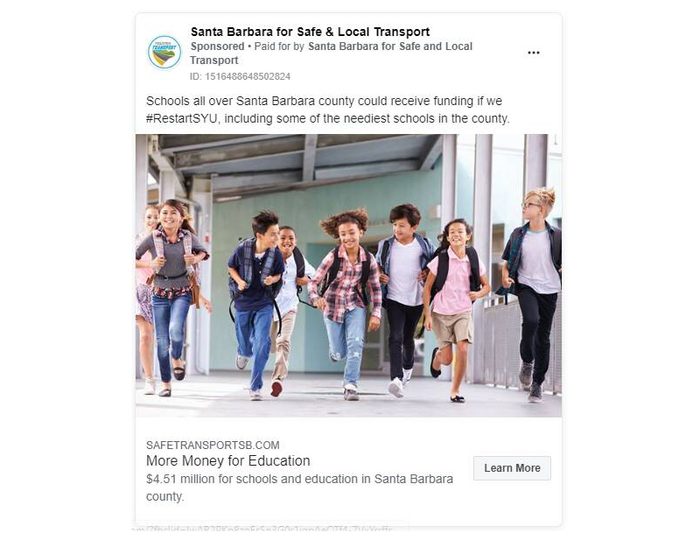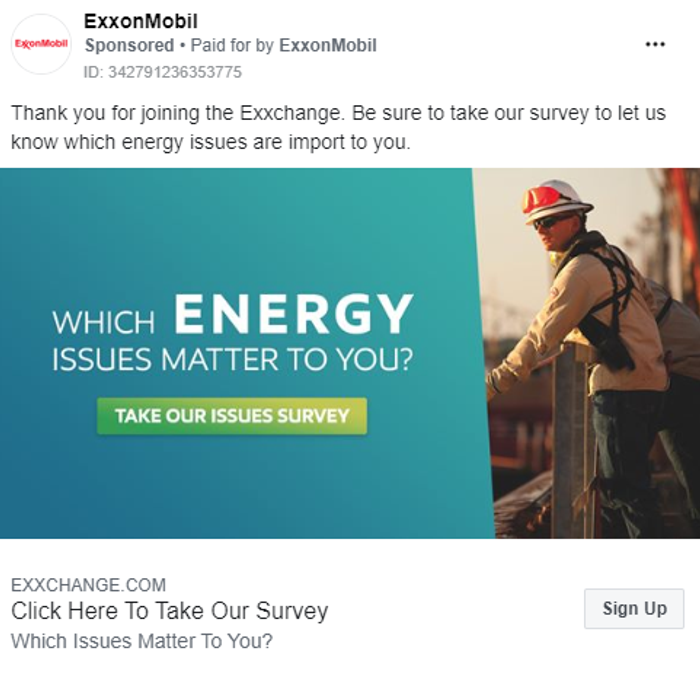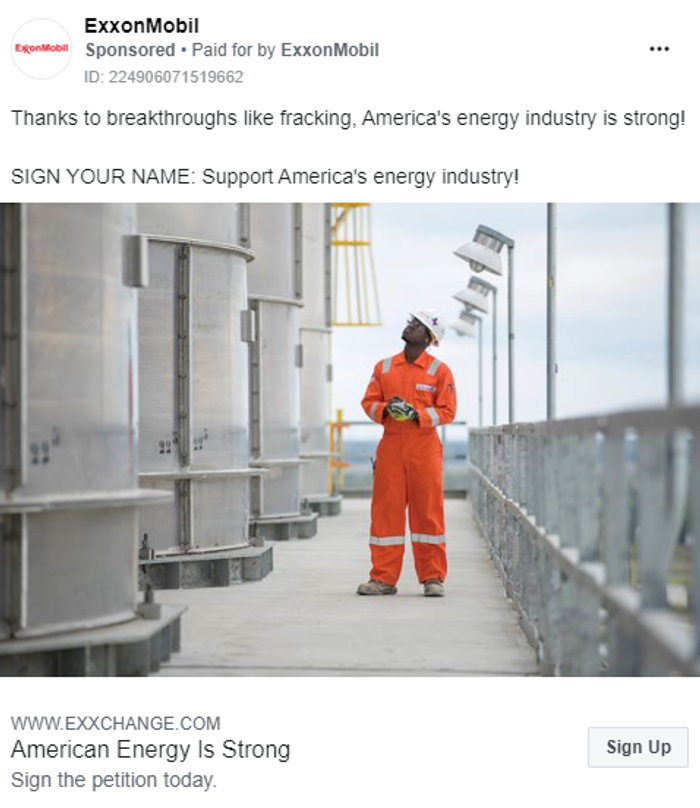Exxon Spends Millions on Facebook To Keep the Fossil Fuel Industry Alive
Aided by a right-wing political consulting firm, the company is rallying supporters to fight for oil and gas interests at every level of government.
Christine MacDonald

In January 2019, an outfit called Santa Barbara for Safe and Local Transport (SBSLT) began running social media advertisements for select California residents. SBSLT’s name and logo — showcasing distant green mountains, a sliver of blue ocean and a highway slicing through them — could be mistaken for that of a typical grassroots group or a governmental highway agency. In reality, SBSLT is part of a campaign by the giant oil corporation Exxon Mobil to change public sentiment about its offshore drilling in California’s Central Coast.
Exxon closed down its local offshore oil platforms in 2015, after a broken pipeline led to the catastrophic Refugio oil spill. Without that pipeline, Exxon has no way to move the oil it pumps from its offshore platforms. As a temporary replacement, the company wants to run oil trucks overland to refineries in central California.
Public support is not on Exxon’s side — a fall 2019 poll found 51% of county residents oppose Exxon’s trucking plan (compared with 32% supporting), and surveys show a majority of Californians oppose more offshore drilling — which might explain why SBSLT has paid for dozens of social media ads over the past two years. The ads have appeared on the screens of California Facebook and Instagram users around 3 million times, and often feature racially diverse school children and coverall-clad oil workers. The ads, of course, offer support for Exxon’s overland trucking plan.
The Santa Barbara County Board of Supervisors will decide Exxon’s local fate, likely next year, but the Santa Barbara ad blitz is just one front in Exxon’s digital politicking onslaught — with battles taking place nationwide. The strategy suggests Exxon is girding for a prolonged fight to secure its increasingly tenuous “social license” to operate, despite the dire predictions of how continued fossil fuel business-as-usual is transforming the planet.

An In These Times investigation, supported by a year-long fellowship from the Leonard C. Goodman Institute for Investigative Reporting, examined 11,622 Exxon social media ads containing around 350 distinct messages that ran in the two-year period from June 1, 2018, to May 31, 2020, and appeared on U.S. Facebook and Instagram users’ screens as many as 265 million times. Facebook (which owns Instagram) has allowed access to the ads it serves through its Ad Library since May 2018, created by Facebook after a number of transparency scandals. In These Times used Python scripts made publicly available by Facebook Research to search and download Ad Library data, then developed custom scripts to analyze and aggregate regional and demographic data. (The full methodology is publicly available here.)
Exxon has spent more than any other major corporation on “social issues, elections, or politics” Facebook ads (outside of Facebook itself), and is the country’s ninth-largest buyer of such ads overall: $15.6 million from May 7, 2018, to October 8, 2020. Almost every other top spender is an organization related to presidential campaigning. The top 100 pages are primarily politicians, nonprofits and other mission-driven organizations: The only major corporation outside of Exxon, Facebook and Instagram is Goldman Sachs, which spent less than a quarter of Exxon’s total.
In These Times examined about $10 million of that Exxon ad spend, a potent complement to the more than $23 million Exxon reportedly spent to directly lobby lawmakers in 2018 and 2019, and the $203 million it spent on traditional TV, radio, print and outdoor ads from June 2018 to June 2020, according to data compiled by Kantar Media’s AdSpender.
Digital advertising is “a very powerful tool to accelerate a range of strategies and tactics that [Exxon] already ha[s],” says Edward Collins, director of corporate lobbying at InfluenceMap, a London-based organization that analyzes and reports on how corporations influence climate policies. Through Facebook, Exxon can target its ads to users related to a particular region, demographic or other variable, communicating directly with any Facebook user who fits the company’s profile of who might be easily persuaded. Using techniques typically seen from activist groups and political campaigns, the ads then ask viewers to sign petitions, take surveys and contact lawmakers in support of Exxon, on issues from fracking to trade.
In many ways, this type of ad campaign on social media is more akin to lobbying or political organizing than advertising, and Exxon has worked with right-wing consulting firm Harris Media, a frequent collaborator with Republican electoral campaigns. Some states do require social media campaigns to be reported as lobbying efforts. Exxon tells In These Times it discloses all of its lobbying activities as required, but experts say inconsistent laws and enforcement means those requirements are generally scant.
“The oil and gas industry is THE engine that powers America’s economy. Take action against ineffective, unnecessary regulations!”
“The U.S. Department of the Interior is close to releasing the next iteration of its five-year offshore leasing plan. Opening these additional areas to drilling will enable the U.S. to access a greater portion of its significant energy resource potential.”
America’s resurgent energy industry has achieved something few thought possible a decade ago - we are the world’s #1 energy producer! SIGN YOUR NAME: Support America’s strong energy industry!
“SURVEY: The energy industry has been the backbone of America for decades. Do you think it’s important to keep our American energy industry strong? Sign your name today!”
“Pipelines support more than 500,000 jobs in the United States. Defend them!”
Many of the Facebook and Instagram ads examined for this story include calls to action, such as a survey or petition. One of Exxon’s biggest campaigns, for example, told Facebook users to contact their lawmakers to support the United States-Mexico-Canada Agreement, the successor to the North American Free Trade Agreement (commonly known as NAFTA) that President Donald Trump ratified earlier this year. Through the new agreement, the oil industry successfully lobbied for special protection allowing it to circumvent Mexico’s court system and use international arbitration in the event of an investment dispute. The campaign even had its own form letter to email to lawmakers. Exxon spent as much as $1.3 million on the campaign ads, appearing on users’ screens as many as 21.4 million times.
Because Facebook only publicly reports ad impressions — the number of times an ad appears, including multiple views by the same person — it is unclear how many people actually acted on the campaign. Facebook also only offers a range of spending and impressions for each ad, rather than an exact amount. For example, on Dec. 20, 2019, Exxon published a series of ads with the text, “Pipelines support more than 500,000 jobs in the United States. Defend them!” For each individual post, Facebook provides a range for spending (for instance, $300 to $399) and impressions (for instance, 7,000 to 8,000). (The lower range is not reported on some ads, so this article presents the upper range unless otherwise noted.)
Even if people do not click an ad or sign a petition, Collins says, the ads “are probably still having an impact, especially if you are seeing it more than a few times — it’s like any other advertisement, after all.”
When users do click, they are often sent to one of Exxon’s digital organizing websites. Exxchange.com, for example, is Exxon’s “advocacy community portal” complete with its own app for smartphones. Before reaching a promised petition, however, users must offer up their personal contact information, building Exxon’s database of supporters.
Exxon declined to comment on how many people have signed up — Exxon says only that the Exxchange is “made up of energy supporters across the country” and “its broad membership is representative of the economic benefits of oil and natural gas in local communities across the nation.” But an ad that ran twice in March 2019 provides a clue. The ads are thank-yous for joining the Exxchange, suggesting they were served primarily to Exxchange members. According to Facebook data, the ads recorded 40,000 impressions, and more than 85% of those who saw the ad were older than 55.

NationBuilder is a nonpartisan digital campaign startup company whose platform is the go-to technology for conservative and Republican causes, including the 2016 Trump campaign — and Exxchange.
NationBuilder (and similar companies favored by liberal causes) makes it quick and inexpensive for political campaigns to map detailed intelligence about, and maintain close contact with, supporters. These digital tools have transformed fundraising and get-out-the-vote efforts by giving organizers targeted information about registered voters in every state. According to Exxon, the oil company “is just one of a number of corporations, associations and nonprofits that utilize digital grassroots advocacy as a necessary communications tool.”
The Exxchange website is built on NationBuilder and was developed by an employee of Harris Media. That company is run by Republican consultant Vincent Harris, once dubbed in Bloomberg as “the man who invented the Republican Internet.” Harris presides over Harris Media in Austin, which develops digital campaigns from video to ghost tweets and text messages for clients. Harris emerged as an online savant during Texas Sen. Ted Cruz’s 2012 primary race and has since continued his work with some of the most conservative Republicans in the country, including (briefly) the Trump 2016 campaign.
Harris’ clients have included Secure America Now, which calls itself a nonpartisan group dedicated to bringing “critical security issues to the forefront of the American debate” and has counted among its board of directors former Republican Gov. Mike Huckabee and national security firebrand John Bolton. The Secure America Now website features, among other things, anti-immigrant rhetoric and a conservative podcast series with such guests as former Republican Speaker of the House Newt Gingrich.
In another case, Exxon hired Harris Media for a campaign to help defeat an anti-fracking ballot measure in Colorado in 2018, known as Proposition 112. The Exxon Mobil Colorado Issue Committee paid Harris Media $40,000 for that campaign alone, according to records on file with the Colorado Secretary of State, and paid Facebook as much as $20,000 to run the created ads. Those ads created more than a million impressions on targeted Colorado residents.
In another industry crossover, Rachel Cross, Exxon’s digital and social media advisor since April 2020, is a former Harris employee. Before that, she worked for Americans for Prosperity, a political arm of the Koch brothers.
Abroad, the U.K.-based nonprofit group Privacy International has called out Harris Media for its “virulent” online ads with “law and order” themes during a 2017 presidential campaign in Kenya, where at least 33 people were killed in election violence. The organization also documented Harris Media’s work for extreme right-wing parties in Germany and France and with Israel’s Likud government.
Lucy Purdon, acting policy director at Privacy International, says Harris Media is part of “a whole ecosystem of companies that are all using this tactic of data collection, profiling and microtargeting in order to reach certain audiences.” She adds, “There is no transparency and no accountability.”
“Look, how do you build a database?” Harris told Politico in a 2015 profile, explaining his methods. “You build a database with enthusiasm. How do you build enthusiasm? With a message. How do you push a message? With social media.”
In a 2018 presentation at a meeting of the Independent Petroleum Association of America, Harris lamented how progressive politicians and advocacy groups like Earthjustice were shaping the narrative around the oil industry on social media. On the subsequent slides he laid out the way to neutralize critics and rally support:
“Before an issue arises Find OUR people, recruit OUR people, and educate them”
“Using a bot to get physical address”
“Activate your folks with tangible advocacy actions to sort and segment the database ahead of an issue”
Harris Media did not respond to multiple requests for comment.
As GOP digital strategist Mindy Finn explained to Politico: “[Digital organizing is] not just raw numbers. It’s analyzing and determining who those people [who are engaging] are and matching them back to voter profiles. … It’s not having the most Facebook likes and clicks, because the ‘who’ matters.”
While only age, sex and state information for each ad is provided by the Facebook Ad Library, Facebook allows ad buyers to target ads based on actual online behavior, in addition to self-reported characteristics like work and education. It can target using online shopping and browsing history, for example, and whether a person is likely to engage with conservative or liberal political content.
“With that kind of targeting,” Lucy Purdon says, “you don’t know what information has been gathered about you, from who, and how you’ve been targeted.”
“Facebook says it’s not a one-to-one match of an identifiable individual,” says digital technology critic Sara Watson, “but the more elements that you start to target against,” the closer you can get to identifying individual people.
Exxon’s social media approach is unusually brazen, according to Collins of InfluenceMap. He tells In These Times that Exxon’s use of social media to lobby the public goes way beyond the rest of the industry, a claim supported by the company’s abnormally high spending on Facebook political ads. Typically, such tactics would be used by political organizations or trade associations, not directly by corporations.
“It does feel novel that the ads would not be about the product but the interests of the company,” Watson says. She likens Exxon’s use of social media ads to the workings of “a Super PAC, but on a much more granular scale.”
In the 11,622 Exxon ads examined for this article, on average, 16% of those who saw each ad were men older than 65, 16% women older than 65, and another 16% men between 55 and 64. In contrast, only about 15% were users 18 – 34 (of any gender). Despite the fact that people older than 65 were a third of those who saw a typical Exxon ad, the group represents only 16% of the total U.S. population. Furthermore, younger people use social media more than older ones. Pew Research Center has used polling to track social media adoption for the past several years, reporting last year that 79% people 18- to 29-years-old are on Facebook and 67% use Instagram, compared to just 46% and 8%, respectively, of senior citizens. Although both Facebook and Exxon declined to comment on what filters Exxon uses to target its ads, this disproportionality suggests the ads are not being sent at random.
Since Exxon’s primary business does not involve selling directly to individuals (the company decided to exit the gas station business in 2008), Watson says Exxon’s personal targeting could build a case for consumer protection, since “most consumers should not have a direct relationship with Exxon.” She adds, “So what right does Exxon have in collecting any consumer data at all, aside from aggregate information about consumer trends?”
Exxon declined to comment on how it uses individual data, but a few recent examples reveal how the oil industry as a whole is embracing the strategies Exxon has been relying upon.
Take the Texas controversy earlier this year over something called prorationing, the (now) rarely used government authority to regulate oil quotas to smooth out fluctuations in the U.S. oil market. The authority hasn’t been exercised in Texas since the 1970s, but this past spring, the Covid-19 shutdown led to an oil glut so large there was nowhere to store any more oil. The Trump administration ordered the U.S. Strategic Petroleum Reserve to fill “to the very top” in March, but his pro-oil policies weren’t enough to make up for the plummeting global demand.
The Texas Railroad Commission considered limiting the number of barrels that oil companies could pump, but free marketeers — linked to the oil industry—succeeded in beating back that proposal.
Multiple energy companies circulated the same anti-proration form letter, including Exxon. The American Petroleum Institute (API), which includes Exxon among its members, fielded an operation under the name Energy Citizens that used the same language.
API used a similar playbook in a 2017 Pennsylvania campaign, bankrolling an organization called Citizens Against Nuclear Bailouts. As revealed in a February Atlantic article, the group targeted residents with a barrage of Facebook ads, direct mail and phone calls. “Perhaps most surprising,” writer Robinson Meyer noted, “the industry has … actually borrowed tactics and ideas from climate activists.”
“It’s a really difficult question about what to do about” direct targeting of individuals with misleading information, says Kathie Treen, a Ph.D. candidate studying climate change misinformation at the University of Exeter, Devon, England. “It does raise all sorts of questions about freedom of speech and democratic rights. Is there a democratic right to be misinformed? Whose responsibility is it and who gets to say what counts, what is misleading and what isn’t, and whose responsibility it is to do something about it?”
12.1 MILLION! That’s how many barrels of oil per day the United States produced in March. Sign up for energy updates and support America’s energy industry!
13.1 MILLION! That’s the number of barrels of oil per day the United States is forecasted to produce in 2020. Sign up for energy updates and support America’s energy industry!
Exxon sent the two ads featured above to social media users nearly 4 million times in April 2019. A year later, headlines about the company’s fortunes had taken a decidedly different turn.
“Big Oil has fallen,” said May Boeve, 350.org executive director, in a triumphant statement emailed to the environmental group’s supporters August 25, the same day the Dow Jones Industrial Average kicked Exxon off its index. The Dow gave Exxon’s spot, which the company had held since 1928, to business software company Salesforce.
Bloomberg called it “a stunning fall from grace,” noting Exxon’s “particularly rapid shift in fortunes” during the lethargic Covid economy. Exxon’s removal came a few weeks after the company reported a second straight quarterly loss. In August, the company announced it would suspend payments to the pension funds of its unionized workforce, though it continued paying stockholder dividends.
Exxon was the most valuable company in the United States as recently as 2011, but its stock began losing value well before the pandemic. “I’m done with fossil fuels.,” declared Wall Street guru Jim Cramer on the show Squawk Box in January. “They’re done. They’re just done. We’re starting to see divestment all over the world.”
As easily accessible oil reserves decline, Exxon and the entire fossil fuel industry is shifting toward lower-profit “unconventional” activities, such as fracking — the process of fracturing shale rock and capturing the oil and gas that gets pushed out.

Clark Williams-Derry, an energy finance analyst with the progressive Institute for Energy Economics and Financial Analysis, says fracking has been “a complete and utter bust,” a “cash flow-negative” business with production costs so high they’ve driven many upstart independent drilling companies into bankruptcy.
“Are they moving into shale because shale is a great opportunity,” Williams-Derry says, “or is it that there is no better opportunity?” He adds it’s only a matter of time before Exxon succumbs to competition from renewable energy companies and stockholders flee en masse.
Meanwhile, the oil industry is attempting to market fracking as a climate-friendly “bridge fuel” to ease the transition from coal and oil to renewables. But new research suggests natural gas might actually be contributing more to carbon emissions than coal—because of gas flaring from wells and leaky pipelines. According to a 2020 study, 3.7% of the methane produced in Texas’ Permian Basin (where Exxon has invested in fracking) leaks away and never makes it to market, more than twice the official EPA estimate for the region. Climate scientists have already determined that if just 3.2% of gas leaks it becomes worse than coal for climate change.
“It breaks my heart,” says climate scientist Peter Kalmus, “that we are basically skewing the planet’s future for the next 10 million years in exchange for a few more years of fracking, of fossil fuel CEOs raking in record profits. … It’s just madness.”
Exxon’s local fights aren’t all winners, like the time it spent $16,000 on ads urging Louisiana residents to “take action” in its fight against the East Baton Rouge Parish School Board over extending expiring industrial tax breaks in January 2019. Those ads were shown more than half a million times, though the company lost the vote.
But the trend is clear: Exxon turns to social media to push its national agenda and try to reverse its general waning public support. Exxon spent up to $1.4 million on social media ads promoting pipeline jobs, for example, appearing 40 million times over the two-year period investigated for this article and particularly targeting residents in states such as Michigan, where pipeline construction is controversial. Other ads pushed for offshore drilling in federal waters and the new trade agreement with Canada and Mexico.
For ads that were posted with the same or similar text multiple times, this shows the mean number of impressions and mean spending for ads with that text.
America is the world’s top energy producer. Do you want to see that continue?
SIGN the petition to add your name today!
ENERGY SURVEY: 94% of federal offshore acreage is off limits to development. Do you support expanding access to offshore energy production?
Answer the survey today!
232,000 Colorado jobs are at risk. Tell Governor Polis to OPPOSE a moratorium on new oil and gas development.
In some states, political social media ads like Exxon’s may need to be disclosed as lobbying efforts. But many states — including Texas, where Exxon is based — have few rules or reporting requirements on social media spending. Even in states with regulations, enforcement is nearly non-existent.
Unlike direct lobbying efforts — in which Exxon would meet directly with lawmakers — “indirect” lobbying (also known as “grassroots”) generally refers to efforts that encourage other people to contact lawmakers, the types of campaigns that include petitions or that aim to influence public opinion about a ballot issue. In some states, according to consulting firm State and Federal Communications, that definition includes ads on social media.
“There really isn’t data [about how much indirect lobbying goes on in the U.S.] because every state is different,” Elizabeth Z. Bartz, State and Federal president and CEO, tells In These Times.
In New York, for instance, social media posts are considered lobbying (and subject to regulation and disclosure) when the post includes a “lobbying activity,” takes “a clear position on the issue in question” and attempts to “influence a public official,” according to a tip sheet from State and Federal. As Exxon tells In These Times, it “complies with all applicable laws and regulations and our lobbying reports are publicly available and filed with the appropriate regulatory agencies and authorities. Where required, our reports to regulators and authorities disclose reportable grassroots lobbying activities.”
But disclosure is often not required.
“Quite frankly, grassroots lobbying is probably the lion’s share of lobbying that goes on at the federal and state levels — and it goes entirely unreported,” says Craig Holman, government affairs lobbyist with the nonprofit group Public Citizen. “As long as [lobbyists] don’t actually knock on the door in D.C. of a member of Congress, it’s not actually reported.”
Reported or not, indirect lobbying is changing the corporate lobbying business, as illustrated by the 2019 annual report of the New York State Joint Commission. In New York state alone in 2019, 24% of registered lobbyists had expanded into indirect lobbying efforts, though only 1% engage exclusively in indirect lobbying. Out of a total of $16.8 million that lobbyists spent on advertising in 2019, digital advocacy and websites accounted for $3.6 million, surpassing the $2.9 million spent on print advertising.
Holman adds that the extent of Exxon’s social media operation “probably is evidence that [indirect lobbying] is far more prevalent today than it used to be. Social media now and the internet provide a perfect vehicle for deceptive advertising.”
“Companies will do it until they can’t,” says Sara Watson. “Facebook and other platforms aren’t going to care about it until the public cares.”
In the mid-2000s, there was an attempt in Congress to pass a federal indirect lobbying disclosure requirement, but it was beaten by what Holman describes as a massive astroturf campaign. Holman adds that similar proposals do exist, but whether they even have a chance depends on the outcome of the presidential election and “whether or not the Democrats are sincere” about reining in corporate abuses.
Even if legal disclosure requirements are passed, Watson says, “there are huge questions about the enforceability of these laws,” particularly when it comes to platforms like Facebook with a business model utterly reliant on targeted online advertising.
Since 2011, a coalition of more than 70 investor groups have pushed for more disclosure of all corporate lobbying efforts, submitting more than 400 lobbying proposals to dozens of companies in the past nine years. Only seven proposals have received majority votes, but the issue is gaining momentum. Multiple such proposals have been submitted to Exxon by the United Steelworkers, including one earlier this year. Exxon recommended shareholders vote against it. It failed to pass but will be resubmitted next year.
“ENERGY SURVEY: 94% of federal offshore acreage is off limits to development. Do you support expanding access to offshore energy production? Answer the survey today!”
In 2019, 58% of the oil refined in California was imported from other countries. Take action and support energy production and local jobs right here in California. Support American Energy in Santa Barbara County. Make your voice heard.
If you have not had a chance, don’t forget to submit your comment letter in support of ExxonMobil’s Interim Trucking Permit. They’re due by 12pm on August 31st!

Exxon’s efforts to use social media to shore up public support are being put to the test in Santa Barbara.
The issue concerns Exxon’s Santa Ynez Unit (SYU), consisting of three offshore oil platforms off the Santa Barbara coast and an onshore processing facility at Las Flores Canyon. In 2015, the pipeline Exxon used to send oil inland to refineries — operated by the Plains All American Pipeline company — spilled 140,000 gallons of crude onto the coastline and into the ocean near Refugio State Beach. It wasn’t the first spill along this breathtaking stretch of Pacific Coast. The Santa Barbara Spill in 1969 was the largest single event in state history. Historians say it helped launch the modern environmental movement and the first Earth Day held the following year.
Without that pipeline, Exxon’s three offshore SYU platforms were retired. Exxon applied, in 2017, for a temporary trucking permit that would enable the company to reopen these wells. If approved, the company would run up to 70 trucks each day (about one every 20 minutes) on Central Coast roads from SYU to California refineries.
On August 12, the Santa Barbara County Planning Commission issued its long-awaited recommendations based on the environmental impact analysis on Exxon’s plan. A public hearing was scheduled for early September, but before that could happen, Phillips 66 announced it was closing its Santa Barbara County refinery — which Exxon had intended as its primary destination for the trucked oil.
A possible alternate path would be a longer route to the Plains Pentland Terminal in neighboring Kern County. In its environmental analysis, however, the commission had suggested Exxon abandon Pentland altogether “to limit truck travel, reduce air emissions, and reduce the likelihood of accidents resulting in spills due to fewer miles traveled.”
The commission may still approve Exxon’s plan, however, and the next step would be a final decision from the Santa Barbara Board of Supervisors. Errin Briggs, supervising planner in the Planning Commission’s Energy Division, says the project is still feasible depending on what modifications Exxon makes to its proposal and that county officials will have to weigh the risks of the oil against area economic benefits.
Santa Barbara for Safe and Local Transport (SBSLT), meanwhile, launched in December 2018. SBSLT’s direct ties to Exxon are apparent. The Santa Maria Sun, a local newspaper, spoke to Exxon Mobil’s then-SYU asset manager for a profile on SBSLT, and reported that SBSLT is “a joint effort between ExxonMobil and interested Santa Barbara County community members”; the group’s website says it’s “Powered by Exxon SYU.”

The SBSLT website describes itself as “a coalition of residents and taxpayers, including local businesses, teachers, law and safety enforcement and ExxonMobil employees.” Exxon does claim support from several unions and business chambers, about 30 businesses and a half dozen local leaders, including some current and former elected officials. To date, SBSLT has spent more than $44,000 on social media advertising, and Exxon has spent more than $2 million in a variety of offshore drilling ads through its primary page.
“We need people to be realistic about the decisions that must be made to live here,” Bob Setbacken admonished other local residents in a comment thread last year on the SBSLT page. He is a retired Santa Barbara resident, according to his Facebook profile, but didn’t return a phone call requesting an interview.
As of October 19, SBSLT’s Facebook page had only 408 likes and 422 followers in a county of 450,000. The page has drawn the ire of local residents. “SYU is a wolf in sheep’s clothing,” Santa Barbara resident Maureen McFadden writes May 22. Amy Foss, another commenter on the page, calls SBSLT “an oil company propaganda page, not a ‘community.’ ”
In October 2019, Facebook said in an online post that it would be adding more information about who is behind Facebook pages, including adding confirmed page owner information and verified city, phone number or website. In October 2020, the SBSLT page continues to be listed as a “community organization,” and under the “Page Transparency” section, it reads: “Santa Barbara for Safe and Local Transport is responsible for this Page,” making no reference to Exxon. But the address provided for SBSLT in the Facebook Ad Library is an ExxonMobil address.
“If we find a Page is concealing its ownership in order to mislead people, we will require it to show more information about who is behind it,” said a spokesperson for Facebook in an emailed statement. “We’re investigating if these Pages follow our rules.”
Beyond Facebook, opposition to Exxon’s Santa Barbara plans is fierce. The opposition has its own grassroots coalition of environmental and community groups, local government supporters and more than 80 businesses. They fear how another oil spill could impact the region’s tourism and fishing industries. Other locals complain the roads just aren’t made to truck that much oil.
In Santa Barbara, as it does across the country, Exxon hopes to turn the tide on its pumping, trucking and fracking through its laxly regulated social media lobbying efforts; its political consultants and campaign software; and its well-funded and heavily motivated supporters. Exxon’s $16-million ad spending spree underscores that the fight against the fossil fuel industry is far from over.
Stephanie Prufer, an oceans campaigner at the Center for Biological Diversity, says she doesn’t think Exxon’s strategy will work for the company, especially among youth.
“I’m not surprised that Exxon is targeting the demographic that they are,” she says, referring to the fact that Exxon ads disproportionately appear on the screens of older social media users. “They know they are not going to be able to get the support of people who are afraid for their own futures. I’m 24 and I worry every single day about what will become of my future if the oil companies keep drilling.”
“The science is so clear,” she adds. “We need to keep oil in the ground. We need to end drilling on our coast, not revive it.”
This article was supported by a grant from the Leonard C. Goodman Institute for Investigative Reporting. David DeMaris served as a technology consultant on this story. Juan Caicedo contributed fact-checking.
Christine MacDonald is an investigative reporter and author, whose work focuses climate change, environmental sustainability and greenwashing. She was a 2019-2020 fellow with the Leonard C. Goodman Institute for Investigative Reporting.








